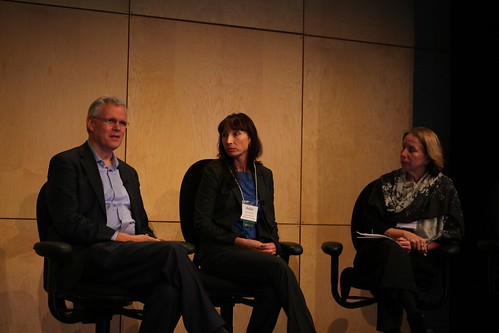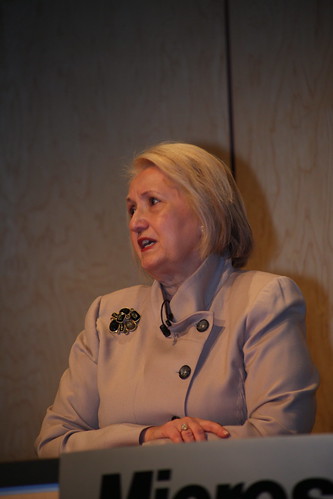Blog
Posted on November 15, 2010
Stephen E. Hanson, professor and vice provost for Global Affairs, at University of Washington discussed the policy recommendations developed by Global Washington in partnership with experts in Washington State. They came up with four principles to increase U.S. foreign assistance effectiveness. These include: transparency and accountability to U.S. taxpayers and international beneficiaries; coherence and coordination across efforts and actors to ensure development goals are prioritized; local ownership of policies by those who will be most affected by them; and targeting populations most in need of aid. Hanson also stressed the need for “patient” metrics because global issues are enormous and their solutions are multi-generational. Most initiatives need time to achieve their goals as well as time for those achievements to be measured accurately.

These policy recommendations set the context for the panel on “The Changing Environment of International Development” where Sam Worthington, President & CEO of InterAction, and Anita Sharma of the United Nations Millennium Campaign discussed the challenges, their recommendations, and the current needs of effective public/private partnerships in global development.
Both panelists discussed the lack of funding and support for foreign aid in our current economic climate. While many governments have pledged aid to support the UN Millennium Development Goals, many have yet to make good on these pledges, explained Sharma, and there is a real need for non-governmental entities and constituencies to continue to support global aid efforts. The U.S. security budget would do well to include international development efforts as a matter of national security.
Worthington underscored the shift of foreign aid from economic assistance toward a focus on economic growth in developing countries. He stressed that the biggest challenge to aid, aside from fiscal constraints, is identifying governments who trust their populations to take part in planning their own development. Part of this development will have to come from private entities, which Worthington argued are more focused on the people who will receive assistance, whereas aid from government entities tends to focus first on the relationship with the nation-state before its people.
Submitted by Nina Carduner

Posted on November 15, 2010
Melanne Verveer was the keynote speaker to a packed house at Global Washington’s second annual conference where the theme was “Bridges to Breakthroughs.” She is recognized as a leader for global women’s issues and is the co-founder and chair of the board of the Vital Voices Global Partnership, an international NGO that supports global women’s leadership. She also worked to advance women’s rights working as Chief of Staff for the First Lady during the Clinton administration. Most recently, she has been established as the US Ambassador for Global Women’s Issues by the Obama administration. As US ambassador, she coordinates foreign policy for international women’s economic, social, and political empowerment.

Verveer discussed the vital importance of incorporating women’s needs and challenges for achieving success in development strategies. “Data shows that strategies that ignore challenges of women have little chance of succeeding…No country can get ahead if it leaves half of it’s citizens behind,” she explained. For example, the Asia Pacific region is being shortchanged $40 billion because women are not enabled to fully realize their economic potential.
Historically, women’s issues have been seen as “soft” issues and not part of the world’s toughest “hard” issues. As a result, development policies and strategies have not succeeded because men and women around the world face different needs. Verveer discussed the difference between male and female farmers. Women make up the majority of the world’s small farmers and face consistent barriers because they are women. Women farmers need micro-credit, land-rights, and access to economic markets. Applying the gender lens to policies that help farmers is critical for creating a lasting positive impact.

Fortunately, there is growing recognition that women’s entrepreneurship and empowerment is central to solve the world’s pressing challenges from climate change to bringing about peace in Afghanistan. Every year, the World Economic Forum (WEF) puts out a yearly report on the gender gap in four areas; health, education, political empowerment, and economic participation. The WEF measures this data because it recognizes that countries where the gap is closing are far more prosperous and economically competitive. On a global level, the gap is closing in health and education, but still lags behind for political and economic participation. Verveer explained that while the potential in women is everywhere, world development is still struggling to implement the strategies that will empower them economically and politically. Therefore, gender equality remains key to progress and sustainable development. Verveer quoted Hillary Clinton’s stance that “Until women around the world are accorded their rights and opportunities to participate fully, global progress and prosperity will have its own glass ceiling.”
Verveer concluded, “the only way we can heal our world and the challenges of our time is to incorporate the needs of and challenges faced by women and girls around the world.”
Submitted by Nina Carduner
Posted on November 8, 2010
By now it is old news- in the 112th Congress, the House will turn from a Democratic to a Republican majority. Committee leadership and composition will change, with implications for U.S. policy in many areas.
What will this change in leadership mean for development? There are two committees where the change will matter most for U.S. development and foreign aid policy- the House Foreign Affairs Committee (HFAC), and the House Appropriations Subcommittee on State and Foreign Operations. Congressman Berman will now be the ranking member (or minority leader) of HFAC, and Congresswoman Ileana Ros-Lehtinen will step up to be the committee chair. As chair of HFAC, Congressman Berman introduced legislation on foreign aid reform, HR 2139, and began to rewrite the Foreign Assistance Act of 1961. As ranking member of the committee, he could still rewrite this bill and introduce it in the House, but it would be up to the new chair to allow it to come to a vote in HFAC.
In Foreign Policy’s blog The Cable, Josh Rogin provides a profile of the new chairwoman, stating that, “[s]he isn’t likely to move Berman’s foreign-aid reform bill through the committee and she is likely to seek cuts in the foreign-aid budget in her authorization bill.” Josh Rogin also reports in The Cable that Texas Congresswoman Kay Granger is seeking to chair the Foreign-Ops Subcommittee, and he notes that while she supported this year’s foreign-ops appropriation bill, she criticized the budget increase given our domestic economic concerns.
Other blogs are somewhat more cautiously optimistic about the future of development policy and foreign aid reform, such as the Center for Global Development: Views from the Center. In this blog, Sarah Jane Staats writes that some good could come out of forcing the administration to work more closely with Congress, though funding will be tight. She also wisely points out that development is not all about money, and the administration might find other ways to work with Congress on development issues, such as through making U.S. trade policy more effective for development. President Obama could reach out to newly-elected Senator Rob Portman (R-OH), former U.S. Trade Representative under the Bush administration, on this issue. (Greater policy coherence between trade and development also happens to be one of Global Washington’s policy recommendations on global development, so we would be interested in seeing this happen.)
And MFAN (the modernizing foreign assistance network) writes that the newly elected members of Congress can find common ground in reforming foreign aid, which is largely considered a bipartisan issue. We need to continue to remind the new House majority party of this fact. All it should take is a glance across the Capitol, where Senators Kerry and Lugar, the Democratic and Republican leaders of the Senate Foreign Relations Committee, have worked together on foreign aid reform through S 1524, the Foreign Assistance Revitalization and Accountability Act of 2009.



